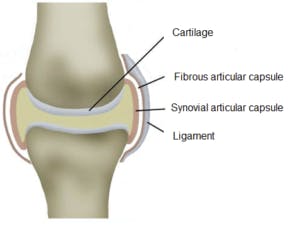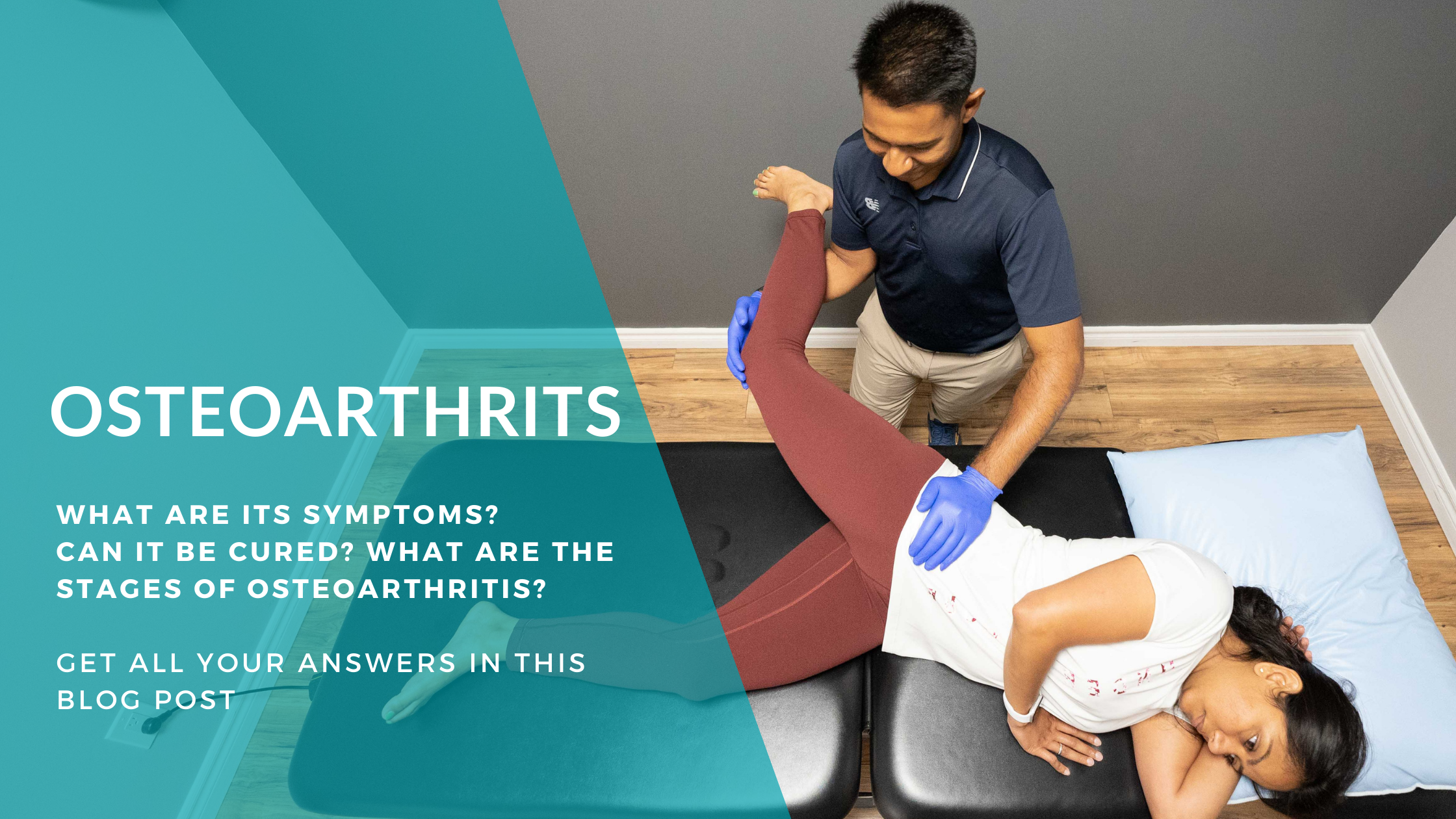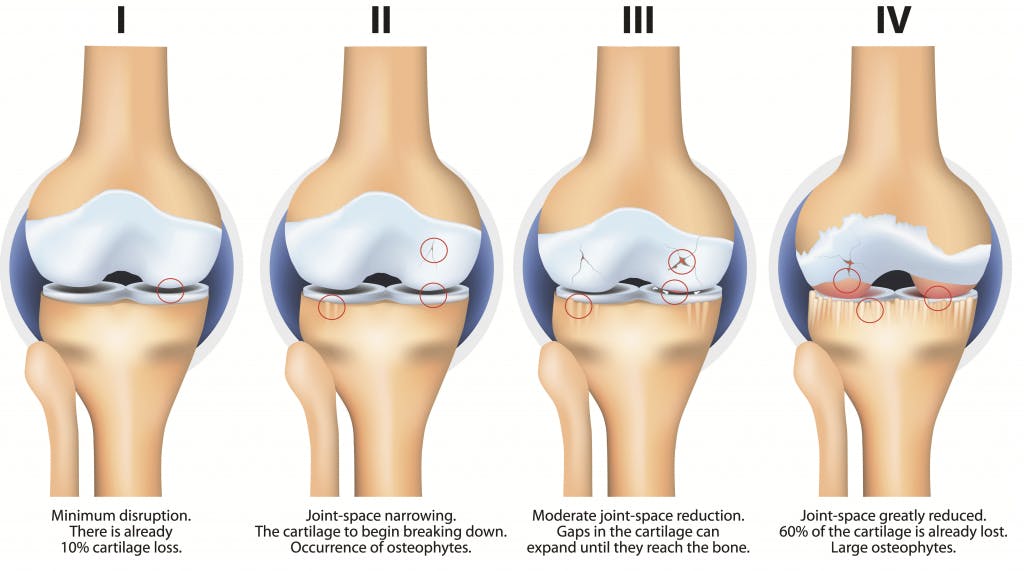Table of content:
- What is Osteoarthritis?
- What is the difference between osteoarthritis and arthritis?
- What are the symptoms of osteoarthritis?
- What are the 4 stages of osteoarthritis?
- What are the treatment options for osteoarthritis?
1. Osteoarthritis – What is it? How does it develop?
Osteoarthritis is a chronic condition that can start with no obvious reason. Degeneration of the cartilage on the ends of bone begins to degrade, thin and can disappear. Though the degeneration begins in the cartilage, osteoarthritis can affect the joint capsule, ligaments, muscles and underlying bone. The leading cause of osteoarthritis is physical inactivity in people over the age of 65 years of age, as cartilage needs moderate load through physical activity to regenerate itself.
Previously thought of Wear and tear disease which was completely wrong. Osteoarthritis = Joint failure.
Osteoarthritis commonly occurs in the hips, knees, wrist, hands and fingers.
How does a healthy knee joint look like?


To provide an example, let’s talk about the largest joint in our body and see how a healthy knee joint looks. The knee joint basically gets us moving every day as it allows the knee to extend and bend back and forth. As you can see in the left image, the knee joint is made up of cartilage, bone, fibrous articular capsule, synovial articular capsule, and ligament.
Fundamentally, cartilage doesn’t contain any blood supply; however, a lot of recent studies show that lack of physical activity, obesity, and sedentary lifestyle increases the risk of osteoarthritis around weight-bearing joints like hip, knee, and spine. cartilage damage happens leading to stiffness, pain, inflammation, and restricted joint movement.
Synovial fluid keeps the Cartilage nourished. With proper motion, cartilage can regenerate.
How do you know if you have osteoarthritis?
The most common symptom of osteoarthritis is pain around the joints. To understand the condition better, you should observe the following symptoms and connect with your physiotherapist or family doctor for a clinical assessment and diagnosis coupled with an effective physiotherapy treatment plan.
According to the Arthritis Society, arthritis affects over 6 million Canadians. Over 20% of the population age 15 and older are having difficulties with activities of daily living. Arthritis causes pain, inflammation, and it can affect one or multiple joints at once.
People who suffer from osteoarthritis are observed reporting soreness and stiffness around joints, decreased range of motion, and pain or swelling around the joint. Contact our highly trained physiotherapist for an assessment today!
2. What is the difference between osteoarthritis and arthritis?
Rheumatoid arthritis and osteoarthritis are just different types of arthritis that share similar characteristics but are different due to the cause behind the joint symptoms. Osteoarthritis is developed because of Overloading, Injury, Muscle weakness or physical inactivity whereas rheumatoid arthritis is an autoimmune disease that may affect multiple joints in the body.
The speed of onset in rheumatoid arthritis is comparatively faster or rapid in nature, ranging from over weeks to months. On the other hand, osteoarthritis is slower and its symptoms can sometimes come and go. For more information on arthritis, read the blog here.
3. What are the symptoms of osteoarthritis?
It is reckoned that all forms of arthritis cause a bit of pain around the joints. Soreness, stiffness, tenderness, and pain are supposed to be the most common symptoms reported by patients suffering from osteoarthritis. A feeling of discomfort and lack of motion is also identified to be a prominent symptoms of osteoarthritis.
The stiffness in the joint is most likely to be experienced in the morning or after long hours of a break but fortunately, physiotherapy exercises can act as a driving force to get you out of that pain. Our physiotherapists at BeActive will perform an in-depth physical assessment of all the joints in the body followed by a customized, effective, and productive physiotherapy treatment plan for pain management, improve range of motion and increasing strength
The feeling of instability or looseness or an urge of giving away are all red flags to be considered for an assessment. Don’t suffer in pain, call us today.
4. What are the four stages of osteoarthritis?
Stage 1: Minor
- Least severe stage of OA
- feel little to no pain
- very minimal damage to the cartilage
- little bone spur growth
Stage 2: Mild
- show more bone spur growth
- start to show some symptoms of joint pain, affected area will start to feel stiff after long sedentary periods
Stage 3 – Moderate
- joint becomes inflamed and starts causing discomfort during normal daily activities
- obvious erosion to the cartilage surface between bones and fibrillation narrows the gap between the bones.
Stage 4 – Sevre
- most painful
- cartilage is almost completely gone, leading to an inflammatory response
- The joint space between the bones are considerably reduced, causing the cartilage to wear off, leaving the joint stiff.
5. What are the treatment options for osteoarthritis?
Treatment of osteoarthritis aims at reducing the key symptoms and improving joint function with adequate education, proper exercises, and a weight-reduction plan if required. Physiotherapy and exercises are considered to be the best relief options when it comes to the treatment of osteoarthritis, according to studies.
All physiotherapists at BeActive Physiotherapy Clinic in Oakville are proactive and dedicated to patient health. Our committed team of physiotherapists ensures that patient health goals and needs are met, with a proper detailed assessment, and by creating an individual physiotherapy treatment program that suits them the best.
Each member of our team understands the impact of joint functions can have on your daily life. As a result, we at BeActive ensure to provide all our services to help our patients to tackle their key symptoms to restore and regain their strength.

As mentioned earlier, education, exercise and weight control are considered to be the first line of treatment. Physiotherapists can help you learn the neuromuscular exercise with right alignment.
Patients with Moderate Osteoarthritis will benefit with First + Second line treatment to provide relief, Improving ROM, Increase strength. Second line can be complemented with TENS, manual therapy, orthotics, Brace and Walking aids.
Only for those with extreme symptoms and later stages of Osteoarthritis, surgery is suggested.
Read more about our team here and learn more about our services here. Check out some simple but effective exercises for osteoarthritis treatment for educational purposes on our website here.



